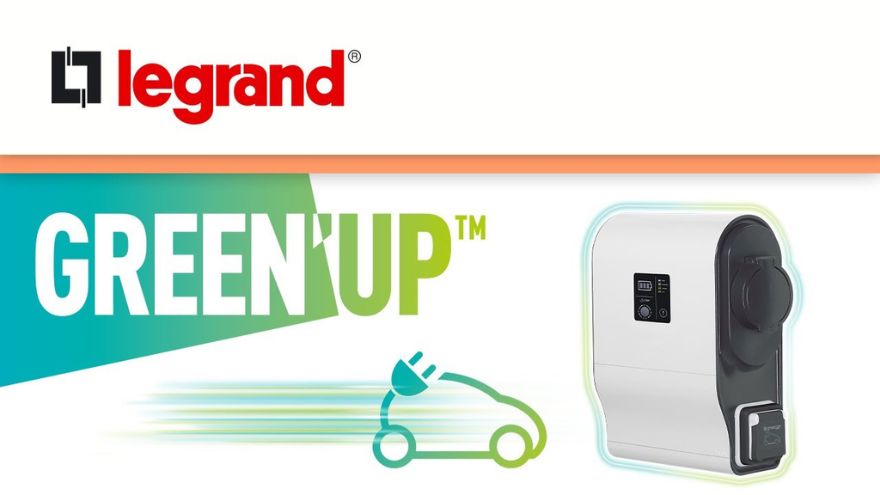The progressive development of electromobility has many advantages, but it also raises certain challenges. The infrastructure is not yet adequately prepared for the dynamically growing number of electric vehicles and there is still a lack of publicly available electric car charging stations . For this reason, many users decide to have their own home station. Which one to choose? What solution will be best? Discover the offer of Legrand Green'up Access sockets and Legrand Green'up Premium charging stations .

What parameters of the charging station are worth paying attention to?
In the case of devices for charging electric vehicles, several parameters will be important, but the most important of them is the maximum available power - the charging speed will depend on it. Most electric cars can be charged using a Mode 2 cable with a plug connected to a regular 230 V household socket with a maximum load capacity of 16 A. For safety reasons, however, it is recommended to charge the vehicle with a lower current (up to 10 A), especially when it is it is a long charging process (lasting several or a dozen or so hours), and the socket to which we connect the vehicle is not a dedicated solution and we are not sure about the quality of its workmanship. This certainty is provided by the choice of reinforced home sockets, e.g. in the Legrand Green'up Access standard, thanks to which we can charge our vehicle with a maximum power of 3.7 kW at a current of 16 A, without the risk of overloading our electrical installation. The biggest disadvantage of this solution is the long time needed to fully charge the car's battery (over 10 hours for a 40 kWh battery). Dedicated alternating current (AC) stations will provide faster charging at home.
What power of the charging station should you choose?
The power of the charging station should be matched to the conditions of the electrical installation at the place of its planned installation (contracted power and its reserve, pre-meter protection, 1-phase or 3-phase installation). The station should be powered by a dedicated circuit with appropriately selected current carrying capacity and protection. In the case of single-phase charging stations, standard powers will range from 3.7 kW (1x16 A) to 7.4 kW (1x32 A), while for 3-phase solutions from 11 kW (3x16 A) to 22 kW (3x32 AND). If our electric vehicle can be charged with a power of 22 kW, this solution will shorten the charging time by approximately 6 times compared to a home socket providing a power of 3.7 kW.
Should the charging station be secured?
Like any other electrical device in our installation, the charging station must also be protected against the effects of overloads and short circuits , and its users against the risk of electric shock. Therefore, when installing a charging station, it is necessary to select appropriate overcurrent and residual current protection. The rated current of these protections is matched to the power of the station. In the case of residual current protection, its type will depend on the factory equipment of the station. If the device is equipped with a module that detects a 6 mA DC leakage current, then a type A or F residual current device is sufficient to protect it. Otherwise, the station must be protected with a type B differential, which significantly increases the cost of the entire installation. It is also recommended to protect the station against the effects of lightning using surge arresters .
Check out Legrand products at the Onninen wholesaler
Advantages of having your own electric vehicle charging station
The biggest advantage of a private charging station is undoubtedly its constant availability, unlike public stations, which may be occupied or out of use at a given moment. When charging at home, we only pay for the electricity we consume, and if our building is equipped with a photovoltaic installation, we can charge the car using the surplus energy produced by the panels, reducing the cost of its use as much as possible.
Check out Legrand Green'up Premium electric vehicle charging stations
The dynamic development of the electromobility market will certainly increase the popularity of private solutions for charging electric cars. Legrand is actively developing its offer and introducing Green'up Premium wallbox charging stations to the market.
These are alternating current solutions with a power range from 3.7 (1-phase) to 22 kW (3-phase), thanks to which it is possible to adapt the appropriate power of the station to the electrical installation in the building . They enable charging one electric or plug-in hybrid car in Mode 3 (Type 2S socket, 3P+N+Z) or Mode 2 (reinforced 2P+Z Green'up Access socket).
All Legrand Green'up Premium solutions are equipped with a 6 mA DC residual current module, so there is no need to protect the station with a type B residual current device - type A or F will be enough.
By default, the stations operate in immediate charging mode after connecting the plug, but it is also possible to set operating schedules using the dedicated "EV Charge" mobile application for smartphones with iOS or Android operating systems or software available for the version with a built-in communication module for remote station management. Charging can also be turned on and off by providing external control signals from a timer, contactor or relay. From the device panel we can also set 3 different delay times (3, 6 or 9 hours). This function may prove useful, for example, when we want to charge our vehicle only during the night tariff, and we do not want to wait to connect the plug until the tariff starts. We can do this earlier and at the same time set the charging start delay .
Check out the full offer of wallboxes at the Onninen wholesaler